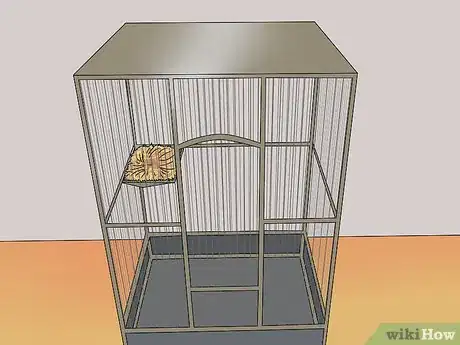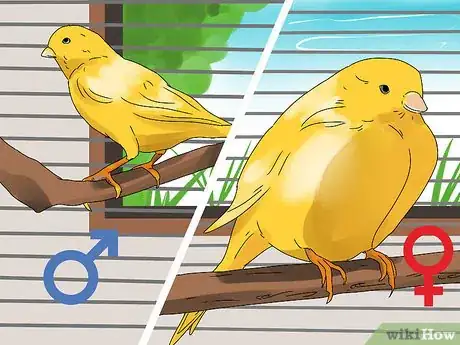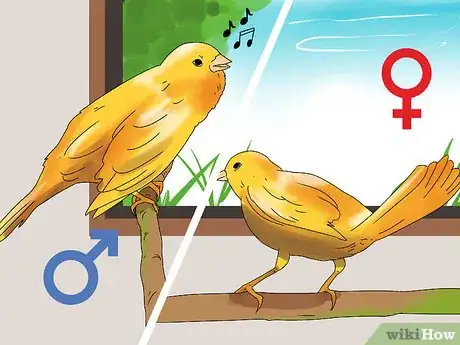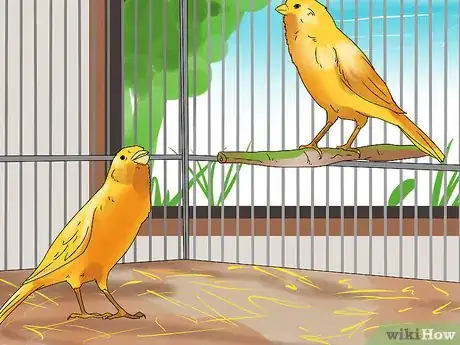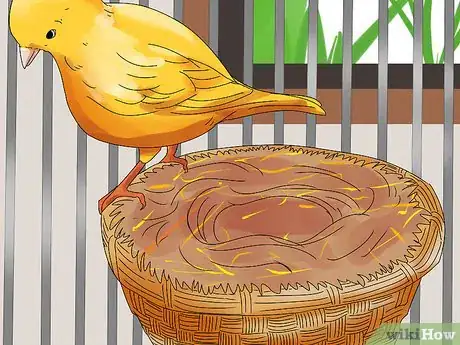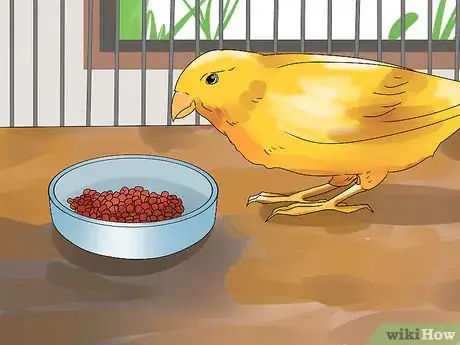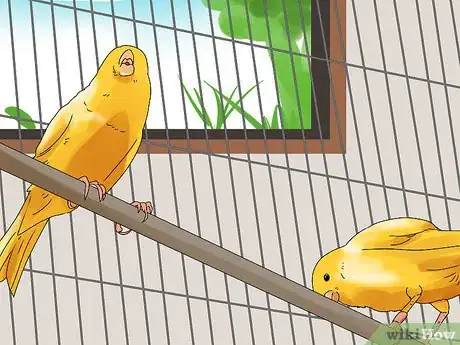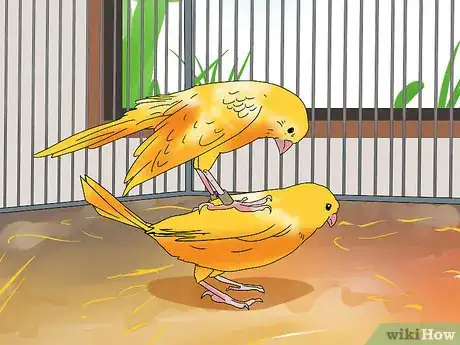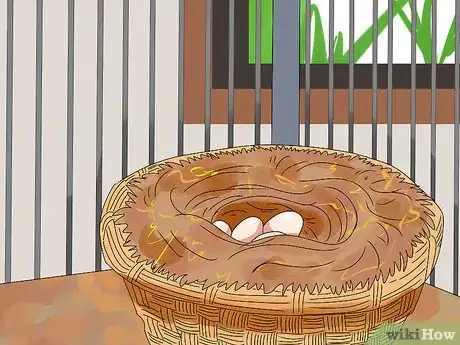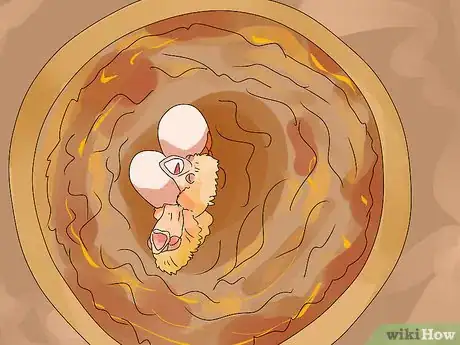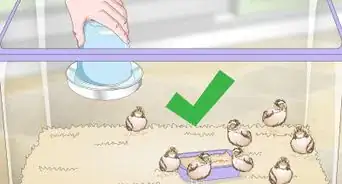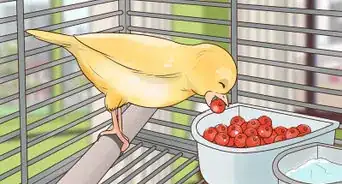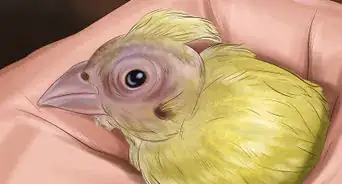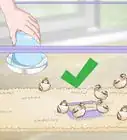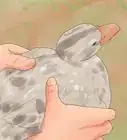This article was co-authored by Pippa Elliott, MRCVS. Dr. Elliott, BVMS, MRCVS is a veterinarian with over 30 years of experience in veterinary surgery and companion animal practice. She graduated from the University of Glasgow in 1987 with a degree in veterinary medicine and surgery. She has worked at the same animal clinic in her hometown for over 20 years.
wikiHow marks an article as reader-approved once it receives enough positive feedback. This article received 21 testimonials and 88% of readers who voted found it helpful, earning it our reader-approved status.
This article has been viewed 424,304 times.
Canaries are wonderful birds to keep in your home because they are easy to care for and relatively content being alone. However, one thing about canaries is not completely simple and that is breeding them. Breeding canaries requires some advance planning, specialized equipment, specific food, and luck. Breeding these birds the proper way is important because it ensures a stress-free environment for them, as well as a greater chance of producing offspring. If you plan to breed canaries, only do so if you can look after all the resulting chicks if they don't find homes.
Steps
Preparing for Your Canaries to Mate
-
1Purchase breeding supplies. In addition to the basic supplies you should already have for your birds, you will need a large cage for the canaries to breed in, a nest for the female to lay its eggs in, and nesting material the female will use to build up the nest. You may also need a light to shine on the cage if your region is getting less than 14 hours of light each day.
- There are special breeding cages available that first allow the male and female canary to become accustomed to one another without allowing contact. These cages have a divider down the middle that can be removed when you are ready to allow your canaries to mate.
- Nests for breeding canaries are available from specialty pet supply providers. If you buy a pre-made nest, you will also need to buy your canaries some nesting material that they can add to the pre-made nest.
-
2Keep canaries separated until time to breed. Unless actively breeding, canaries must be kept in their own cages. Males tend to fight and a male might kill the female if she is not ready to breed. Their cages can, however, be kept in the same room.Advertisement
-
3Watch for signs that the canaries are in "condition," or ready to breed. Breeding usually occurs in the Spring. Canaries like to breed when the temperature is around 70 degrees and there are about 14 hours of light. These conditions can be replicated indoors, in order to promote breeding. Male and female canaries act differently when they are ready to breed.
- Male canaries will usually come into condition before the female. Signs that they're ready to mate include dropping their wings when they sing and singing harsher and louder songs. They may also dance around on their perch and be more territorial when other males are nearby.
- Females will most often begin to tear paper, as if readying a nest, when they come into condition. The most certain sign of their readiness, however, is when their vent appears red and swollen. They may also raise their tails and appear to squat when males are nearby.
-
4Place the male and female canaries near each other, but not in the same cage.[1] Put their cages side by side or place both birds in a special breeding cage that has a central divider. This will get the birds used to each other and their behavior with each other will tell you if they are ready to mate.
-
5Add a nest to the female's side of the breeding cage. If you are just using a large cage instead of a breeding cage, simply place the nest in the female's cage. Once the female has begun adding nesting material to her nest, it is a sign that she is getting ready to mate.[2]
-
6Feed a proper diet. Nesting canaries should be fed a proper diet that consists of pelleted food, enriched seed, soft food, and additional calcium from a few weeks before breeding until they are done feeding their chicks. A cuttle-bone or grit is recommended to give the hen the additional calcium required for producing healthy eggs. These specialty foods are available through pet supply companies.
Breeding Your Canaries
-
1Place the canaries together once there are signs they are ready to breed. This can be indicated by kissing between the canaries and the female beginning to putting nesting material in the nest. If both are in condition, your male and female canaries will begin to "kiss" through the bars of the wire partition by touching beaks. Kissing may happen right away or it may take a few days after you place the canaries near each other. Once they are ready to breed, you can put them in the same cage.
- Watch for any fighting. If they begin to fight, separate them immediately and watch for signs that they're still both in condition. However, mating can be relatively aggressive, so be sure that you are not witnessing breeding instead of regular fighting.
-
2Watch for breeding behavior. This will begin with the male courting the female canary. Once she is ready, she will crouch down, signaling her willingness. The male will then mount the female is short, successive bursts.
-
3Look for eggs in the nest. The female canary can lay anywhere from 2 to 6 eggs. The female will lay one egg a day, usually in the morning. It typically takes 14 days for canary chicks to hatch. They should hatch without any assistance.
-
4Keep chicks with male and female canaries until they begin eating on their own. This usually happens when the chicks are around 3 weeks of age. At first the mother canary will stay with the babies all the time and the father will bring the mother food. Then, gradually, the father will take over feeding the chicks, making sure that they get enough to eat.[3] Once the chicks begin eating on their own and are fully fledged, meaning their wing feathers have developed enough to fly, you may remove them to their own cage.
- At this point you should also separate the parents again as well.
Expert Q&A
Did you know you can get expert answers for this article?
Unlock expert answers by supporting wikiHow
-
QuestionHow do I get my birds to produce healthy eggs that hatch?
 Pippa Elliott, MRCVSDr. Elliott, BVMS, MRCVS is a veterinarian with over 30 years of experience in veterinary surgery and companion animal practice. She graduated from the University of Glasgow in 1987 with a degree in veterinary medicine and surgery. She has worked at the same animal clinic in her hometown for over 20 years.
Pippa Elliott, MRCVSDr. Elliott, BVMS, MRCVS is a veterinarian with over 30 years of experience in veterinary surgery and companion animal practice. She graduated from the University of Glasgow in 1987 with a degree in veterinary medicine and surgery. She has worked at the same animal clinic in her hometown for over 20 years.
Veterinarian Make sure you have a male and a female bird, plus they are both eating a healthy diet. Also, watch the mother to make sure she is paying proper attention to the eggs and incubating them. If she is distracted and spends a lot of time away from the nest her eggs may be getting chilled. Unfortunately it is very difficult to successfully hatch the eggs in an incubator, so she is their best chance. Best of luck.
Make sure you have a male and a female bird, plus they are both eating a healthy diet. Also, watch the mother to make sure she is paying proper attention to the eggs and incubating them. If she is distracted and spends a lot of time away from the nest her eggs may be getting chilled. Unfortunately it is very difficult to successfully hatch the eggs in an incubator, so she is their best chance. Best of luck. -
QuestionCan canaries hatch their eggs in an outdoor cage if the temperature is around 50 degrees celsius?
 Pippa Elliott, MRCVSDr. Elliott, BVMS, MRCVS is a veterinarian with over 30 years of experience in veterinary surgery and companion animal practice. She graduated from the University of Glasgow in 1987 with a degree in veterinary medicine and surgery. She has worked at the same animal clinic in her hometown for over 20 years.
Pippa Elliott, MRCVSDr. Elliott, BVMS, MRCVS is a veterinarian with over 30 years of experience in veterinary surgery and companion animal practice. She graduated from the University of Glasgow in 1987 with a degree in veterinary medicine and surgery. She has worked at the same animal clinic in her hometown for over 20 years.
Veterinarian
Warnings
- Canaries are not normally social birds, so just placing a male and female bird in the same cage when they are not ready to mate is more likely to result in a disaster than in eggs. You need to be very sure that your birds are ready to mate when you introduce them to each other.⧼thumbs_response⧽
References
About This Article
To breed canaries, start by keeping the male and female in separate cages until the springtime, when they usually mate. Then, look for the male to sing louder and harsher songs, and the female to start tearing paper, as if she’s building a nest. When the canaries begin showing these signs that they’re “in condition,” move their cages next to each other, and watch what happens. You’ll know they’re ready to mate when they start kissing through the bars of their cages. At that point, move the male into the female’s cage, and let nature take its course! For tips from our Veterinary reviewer on how to look for other signs that your canaries are ready to mate, scroll down!
